Dr. Julie Evans on Free Agent Learning
Key Points
-
For today’s students, learning is a 24/7 enterprise.
-
Our schools and districts tend to start from the place of being resource deficient, but educators and edleaders have a tremendous asset – the voice, the experience and the perspectives of their students.
-
A fundamental barrier to teachers accepting free agent learners is that we have to accept new and different types of learning, new and different types of value.
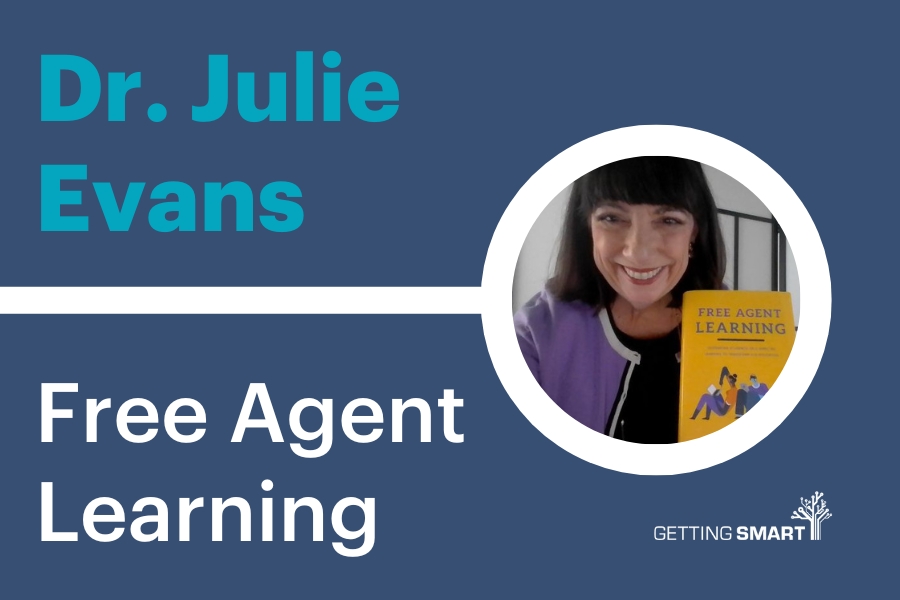
Interested in learning more about the World of Work? We’d love to see you at the summit. Register here.
On this episode of the Getting Smart Podcast, Nate McClennen is joined by Dr. Julie Evans, CEO of Project Tomorrow, and author of the new book Free Agent Learning. Project Tomorrow runs Speak Up which routinely surveys young people about their perceptions and opinions about school. She is a deep believer in listening to learners and providing agency for their learning.
Nate McLennan: Welcome to the Getting Smart podcast. I’m Nate McLennan, and I will be hosting this conversation today. So many school models are prescriptive and compliance-based, yet the world is becoming more complex, more uncertain, and even more mutual—we’re dependent on one another to solve really hard challenges. Much of our thinking at Getting Smart is about how to better connect what happens in school to what happens in the world and how every young person deserves the opportunity to have and contribute to a better future for all. Innovative schools are building profiles of a learner or graduate and then wrapping these engaging real-world projects around these profiles. Learner-centered with voice, choice, and agency built into the experience, along with developing the core and technical skills to apply to this purposeful work. The school models the real world. So today, I’m super excited to speak with Dr. Julie Evans, who’s the CEO of Project Tomorrow and the author of the recently released book Free Agent Learning. Project Tomorrow runs Speak Up, which routinely surveys young people about their perceptions and opinions on school. She’s a deep believer in listening to learners and providing agency for their learning. So welcome, Julie. I’m excited to have you today.
Dr. Julie Evans: It’s great to be here, Nate. Thanks so much for inviting me.
Nate McLennan: All right, so we are talking a lot about learning. Thinking about you as a learner—not necessarily as an author right now or a CEO—what is something you’re learning right now?
Dr. Julie Evans: You know, Nate, I’ve been talking a lot about the book, so some of my most recent learnings really have to do with what’s happening in schools and districts in terms of having a new awakening about the importance of listening to the ideas of students, which absolutely tickles my heart, to be honest with you. So many new ideas about engaging students in learning, bringing their skills to the forefront, and really listening to their ideas. I think that’s really encouraging. I’ve been super excited about learning about that lately.
Nate McLennan: Yeah, it’s really interesting how one of the best things we can do to improve learning, teaching, and education is actually to ask young people what they think. You’re really at the heart of that, and I’m curious about your journey. How did you get involved with education and Project Tomorrow? What was your journey to get to where you are now, where you wrote a book about free-agent learning?
Dr. Julie Evans: Yeah, interesting question, Nate. Thank you for asking. My background is in the technology industry. I grew up in technology from a sales and marketing perspective and then was with two ed-tech startups in the late ’90s. Both of those startups had successful exit strategies, and as part of that work, I was recruited to run what was then called NetDay, the predecessor of Project Tomorrow. At first, I was somewhat reluctant—I was an ed-tech startup person, not a nonprofit education person. But it’s been fascinating to think about the future of education through the lens of technology and apply business practices to it, focusing on different types of outcomes. I sort of backdoored myself into education from the technology world, but it’s been really positive to have that background.
Nate McLennan: I do think it has. When we bring diverse perspectives and backgrounds in, the outcome is better. Speak Up is a program—a free survey program for anyone in the country working with students. How does it fit with the Project Tomorrow mission? Is it one of many things you do, or is it the predominant thing?
Dr. Julie Evans: Great question, Nate. Project Tomorrow is an education nonprofit group focused on understanding how to increase school and district leadership capacities to make the best decisions and improve education for all students, with equity at the forefront. As part of that, we strongly believe in translating research into practice. To walk the talk, we started the Speak Up research project, offering K-12 schools and districts in the country the opportunity to use our online surveys to collect feedback from students, teachers, parents, administrators, and community members. They use this data to inform policies, programs, learning initiatives, and ways of improving school. We also share our research nationally at conferences, in reports, and briefings so that everyone can be informed by the Speak Up data. We take what we learn from the data to implement focused pilot programs. Currently, we’re running pilot programs in New York City and Michigan on integrating computational thinking within classrooms, all derived from our Speak Up research.
Nate McLennan: So, really, student voice informs your path forward almost all the time. That’s a powerful piece. Sometimes I wonder if students realize that by filling out a survey, they’re actually helping to push forward more learner-centered, student-centered, agency-filled approaches.
Dr. Julie Evans: Every part of it!
Nate McLennan: Now, you’ve just written a book—congratulations! We’ll put in the show notes how listeners can acquire the book from Amazon or other locations. So, Free Agent Learning—you’ve obviously learned something from the students you’ve been listening to. Did it all come together in this book? What is free-agent learning, and did all the data point in this direction as a critical way to head?
Dr. Julie Evans: Interesting question, Nate. First, I’ll define free-agent learning for context. Free-agent learning is an ecosystem where students self-direct learning around areas of interest, passion, and curiosity on their own, outside of school—not teacher-sponsored or assigned, not for homework or school projects. It comes from their intrinsic motivation to learn about something. Students have always engaged in self-directed learning. In another era, if someone wanted to learn about astronomy, they’d go to the public library, find a book—if it was available—and borrow it. Today, technology enables students to be free-agent learners anytime, anywhere. With internet access through smartphones and other devices, they can drive their own educational destiny without being tethered to educational institutions. So, free-agent learning is essentially this ecosystem enabled by technology where students are in the driver’s seat.
We discovered this phenomenon through Speak Up. Initially, we were focused on collecting student feedback about technology use in schools. I conduct focus groups, panel discussions, and one-on-one interviews with students every year. What kept coming up was that students wanted to talk about their technology use outside of school, even those from under-resourced communities. So, we began to gather data about their learning experiences outside school, and it became clear that these aren’t two separate worlds but one seamless experience for students. This influenced their expectations and perceptions of in-school experiences.
Nate McLennan: Fascinating. Neuroscience tells us that humans learn every moment they’re awake. You’re tapping into the idea that students, as free-agent learners, have more access to learning than ever. But did you find any demographic differences—socioeconomic status, race, or geographic location—affecting students’ engagement in free-agent learning?
Dr. Julie Evans: Great question, Nate. When analyzing free-agent learning activities, we looked at variables like gender, tech savviness, community type, home demographics, and racial or cultural identity. We found minor differences—girls were more likely to use social media for learning, while boys leaned toward workplace skills from games. However, statistically, these differences were small. Even for students with varying broadband access at home, we didn’t see significant differences in activity types or frequency. Students primarily use smartphones for self-directed learning, and with widespread Wi-Fi, they can engage in learning experiences without major demographic disparities. This universality underscores that, as humans, we’re all curious and eager to learn.
Nate McLennan: That’s powerful. Your findings indicate that every young person wants to learn if it’s something interesting to them and they have a choice in it. This dispels the myth that some students aren’t good learners; it’s more about what and how they’re learning. So, thinking about how this influences in-school structures, what systems and lessons can schools apply from free-agent learning?
Dr. Julie Evans: A key reason I wrote the book was to help educators understand they have an incredible asset in their students’ voices and experiences. In Chapter 10, I identify 10 ways school and district leaders can integrate free-agent learning to transform in-school experiences. One simple step is to incorporate into the morning routine or before content, asking students, “What did you learn yesterday outside of school?” This respects students’ self-directed learning, helps teachers understand them as whole individuals, and can personalize learning based on student interests. This doesn’t require major structural changes and has profound impacts—teachers discover more about students’ curiosities, and students feel valued.
Nate McLennan: I love that simple yet powerful idea. It’s about seeing the learner as a whole person and respecting what they bring to the classroom. That small act can have a huge impact on both the teacher and the student. I imagine the other nine strategies in the book are just as insightful.
Dr. Julie Evans: Absolutely. It’s about both the student and teacher benefiting from this interaction. Often, we assume learning only happens during the school day. However, we have data showing that we actually have an engagement crisis, especially in middle and high schools, with about 50% of students saying they’re engaged in school most of the time. This predates the pandemic. By incorporating students’ interests and acknowledging their learning outside of school, we can address this engagement disconnect.
Nate McLennan: Thank you for that insight, Julie. It’s crucial to recognize that engagement issues aren’t new. So, are there explicit skills students need to succeed as free-agent learners, or do you believe that given the opportunity, all students will naturally thrive in this environment? Do you think these skills are inherent, or do they need to be explicitly taught?
Dr. Julie Evans: Thanks for that, Nate. I definitely believe there are skills that students need to be effective free-agent learners. While students are naturally curious, which drives a lot of self-directed learning, there’s a need to teach specific skills to make this learning more effective. For instance, using technology effectively as a learning tool is essential. However, in schools, we often use technology in limited ways, and we don’t teach students how to be good researchers or how to evaluate the accuracy and credibility of information. This brings us to the importance of media and information literacy. Students need these skills to navigate free-agent learning effectively outside of school.
Another critical area is content creation. When students create content—whether it’s a video on YouTube or sharing a piece of writing to receive feedback—they view it as a learning process. Teaching students to create quality content, to communicate effectively, and to understand audience and purpose will support their free-agent learning experiences. These are essential skills that will help them manage the wealth of information they encounter and contribute meaningfully.
Nate McLennan: That’s a powerful insight. Media literacy is indeed a superpower in our current world. The ability to evaluate sources, understand bias, and discern the credibility of information is essential. I also hadn’t considered content creation as part of that skill set, but you’re right—it’s about preparing students to contribute positively and accurately to the information ecosystem. Given the constraints of school—curriculum standards, the pressure to cover content—how can teachers integrate the concept of free-agent learning while still meeting these demands?
Dr. Julie Evans: It starts with re-evaluating what we consider to be valid learning. This is a difficult but essential shift. One barrier to integrating free-agent learning is the mindset that the only valid learning occurs within the school day, directed by a teacher. If we expand our perspective to recognize that meaningful learning is happening outside school, we can bring those experiences into the classroom and validate them as part of a student’s learning journey. This doesn’t detract from content knowledge acquisition; rather, it enhances skill development by connecting learning to the real world.
Tony Wagner talks about the need to focus on skills that students actually need to be successful in the future. By recognizing and incorporating what students are learning independently, we can address the engagement and relevance gaps. Even small steps—like acknowledging students’ out-of-school learning—can help prepare them for a world where lifelong learning and adaptability are essential.
Nate McLennan: I love that. By valuing what students bring in from their outside learning, teachers can provide context and relevance to the curriculum. It’s a way to personalize learning without major overhauls. Julie, I’m learning a lot from this conversation. What’s the most important takeaway you’d like our listeners to have from your work? And secondly, is there someone or an organization you’d like to amplify, where listeners can learn more about this type of work?
Dr. Julie Evans: Absolutely. My main takeaway—my mantra, really—is that schools and districts have an incredible asset right in front of them: the ideas, views, and experiences of their students. We often see schools start from a resource-deficient standpoint, wondering how to improve learning outcomes. But right in front of them, they have this tremendous resource that could help guide their decisions and shape a more relevant and engaging learning environment.
As for someone I’d like to amplify, I’d encourage people to pay attention to the work of Thomas Arnett from the Christensen Institute. Every time I read something from him, I learn something new, and it challenges my perspective on our work in education. His writing pushes us to think differently about learning, systems, and the future of education.
Nate McLennan: Thank you for sharing that. We’re definitely fans of the Christensen Institute and their work. Let me try to summarize what I’ve learned from our conversation today, as I like to do. First, only about 50% of middle and high school students are engaged in what they’re learning at school, and that’s not a post-pandemic issue—it’s been a persistent challenge. Second, all students are free-agent learners, inherently curious and motivated to learn when they’re engaged in something they care about. This means that every student has the capacity for self-directed learning if they’re given the opportunity.
Third, schools should be asking students regularly about their learning experiences. It’s something too few schools are doing, but it would yield incredibly valuable insights. Fourth, motivation in free-agent learning comes from autonomy, mastery, and purpose—students are more likely to engage when they have a choice, can work toward something meaningful, and see improvement. Fifth, one simple practice teachers can implement is to start each day by asking students, “What did you learn yesterday?” This can deepen relationships, bring relevance, and personalize learning.
Finally, I was intrigued by your emphasis on media literacy as a necessary skill in today’s world. Young people need to develop the skills to navigate and create content responsibly, which will serve them as lifelong learners. Julie, thank you for sharing your insights and for all you’re doing through Project Tomorrow. Where can listeners go to learn more about your work?
Dr. Julie Evans: Thank you, Nate. Listeners can learn more about Project Tomorrow at tomorrow.org. That’s an easy URL to remember! You’ll find a lot of our Speak Up research there, including reports, infographics, and briefings. If any schools or districts want to participate in the Speak Up Surveys, they’re open annually, and it’s a free service we provide. This is a great way to leverage that asset of student voice we’ve been talking about.
Nate McLennan: Fantastic. We’ll include links to your new book and other resources in the show notes. Julie, thank you again for your time and for the impactful work you’re doing. It’s been a pleasure having this conversation with you.
Dr. Julie Evans: Thank you, Nate. I really enjoyed it.
Links:


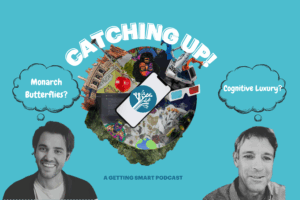

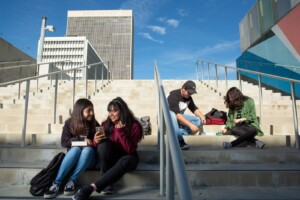
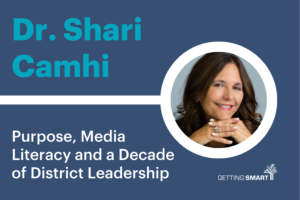
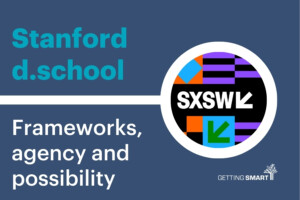

0 Comments
Leave a Comment
Your email address will not be published. All fields are required.